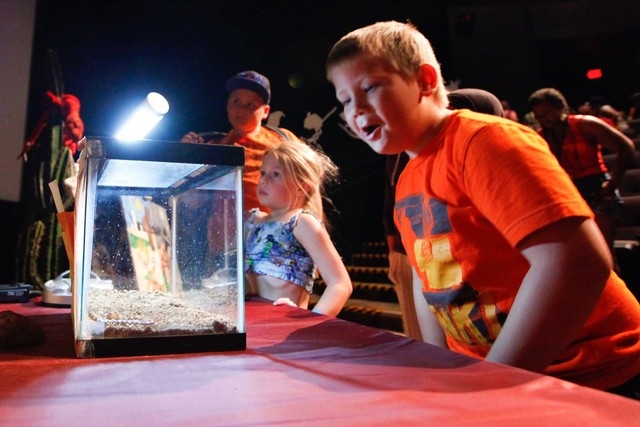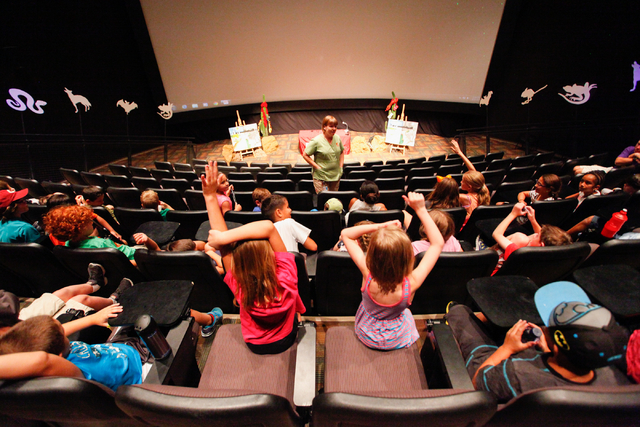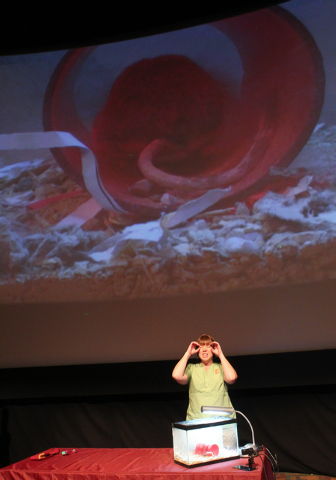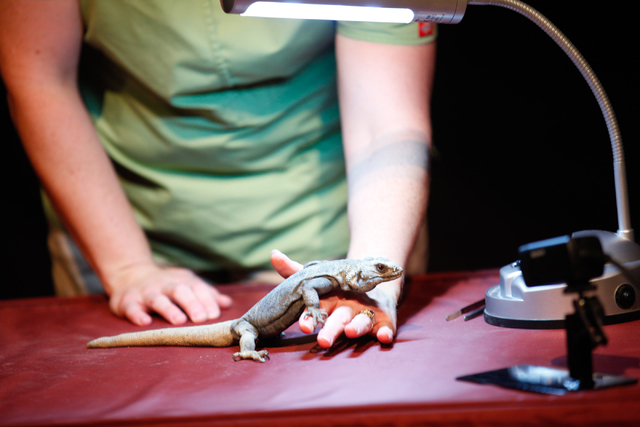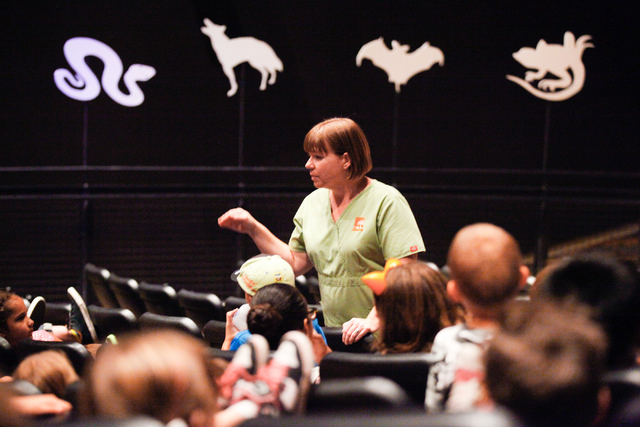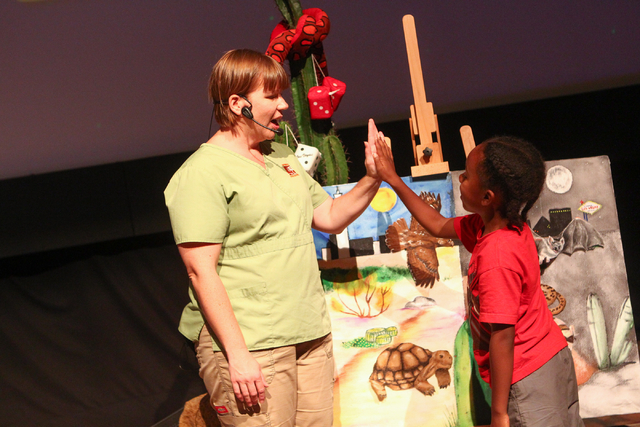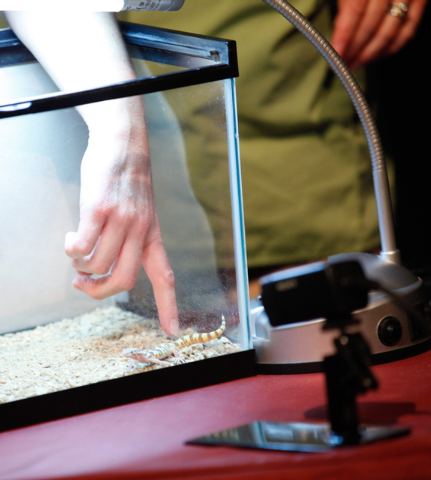Desert creatures star in Springs Preserve summer show
The results are in.
Desert tortoise: Yay.
Vinegaroon: Nay.
Scorpion: Yeech.
The vote wasn’t official, of course. But if audience consensus during a presentation last week of the “Vegas Night Life Animal Show” at the Springs Preserve means anything, public opinion is solid that arachnids just aren’t as cuddly as slow-moving, hard-shelled reptiles.
The show runs twice daily, at 11 a.m. and 1 p.m., until Sept. 1 in the Big Springs Theater inside the Springs Preserve’s Origen Museum as part of the preserve’s summer programming. The presentation runs about 25 minutes and is free for Springs Preserve members or included with regular Springs Preserve admission.
Each show features live guest appearances by more than a half dozen animals from the preserve’s collection, so guests may see at their particular show lizards, kangaroo rats, centipedes or other animals. most of which will be nocturnal and one or two of which will be diurnal. Although no deadly animals were featured in one afternoon show last week — a previous Springs Preserve show, “Venom,” covered that niche of the animal kingdom well enough — several of the animals shown live on a large video screen aren’t ones most of us would want to encounter by surprise.
The cast of characters, introduced by Thomas O’Toole, Springs Preserve zoology supervisor, included the desert tortoise, a desert nightsnake — which, although venomous, is considered harmless to humans — a pocket gopher and that vinegaroon, a creepy-looking arachnid (which, the audience learns, all have eight legs) and a strange tail that has earned it the nickname “whip scorpion.”
O’Toole, who presents information with a wry sense of humor, describes the vinegaroon as the desert’s most misunderstood creature, adding that it employs as its primary defense against predators the ability to secrete an acetic acid compound that brings to mind the acrid scent of the strongest vinegar you can imagine.
Speaking of scorpions, last week’s show also included a desert hairy scorpion, greeted by kids in the audience with what seemed to be equal parts creeped-out horror and eerie fascination.
The desert hairy scorpion is native to Southern Nevada, O’Toole tells the audience as the thing itself gambols about in a terrarium, its size magnified to horror movie-like proportions on the video screen behind him. Another commonly seen scorpion here, the bark scorpion, isn’t native to Southern Nevada, O’Toole says, but was introduced here via vegetation brought in from Arizona.
The desert hairy scorpion is, comparatively speaking, the more benign of the two species, packing a relatively mild (for humans) venom, O’Toole adds, explaining, too, that scorpions glow under black light and can be detected in that way in valley backyards.
“Or in your house,” a dad in the audience adds. A few seats away, his daughter, looking suddenly uncomfortable, looks his way and replies with a shaky, “Where?”
O’Toole’s presentation includes two interactive games played by kids chosen from the audience. In the first, players are asked to match animals to either daytime (diurnal) or nighttime (nocturnal) scenes, depending on when they’re most active. In the other, an homage to echolocation, the sonar-like system by which bats locate prey, is demonstrated by blindfold and finger clickers.
When the show ends, about a half-dozen kids cluster around O’Toole to ask more questions.
“I’d say the majority of them love all the creepy-crawlies,” O’Toole says, and, for those who aren’t terribly fond of them, the show at least offers a short respite in air-conditioned surroundings.
O’Toole has been at the Springs Preserve since 2006, arriving there after jobs at The Mirage’s dolphin habitat and Shark Reef Aquarium at Mandalay Bay. He says daily live animal shows have been part of the Springs Preserve’s summer schedule for three years.
Previous shows have centered around venomous animals and birds of prey.
“We mix it up and just keep changing it to give people reason to keep coming back,” he says.
The shows allow guests to learn about the natural world in a vivid and memorable way. O’Toole remembers his own youth in suburban Chicago and the effect trips he took to the zoo and the aquarium there had on him. He hopes the kids who come to the Springs Preserve shows will experience something similar.
What are some of the strangest questions kids ask? Among Springs Preserve summer campers, he says, “every year we have the kind of questions: Which animal would win a fight, this or that? Would it be a black widow spider or a scorpion? The snake versus the gopher?
“Another common question I get is, ‘What’s your favorite animal?’ I always feel like, it’s kind of like, ‘Who is your favorite kid?’ I give the pat answer, ‘Well, it kind of depends what I’m working with. That’s because they’re all so cool.’ “
Why do so many kids have a fascination with — even an affection for — even the creepiest creatures? “That’s a good question,” he says. “Even as a child, I’d go to the zoo or the aquarium and I was just fascinated.
“I guess maybe because you’re looking for some crazy cool pet you could have, and you’d be the only one with a vinegaroon or a hissing cockroach or something.”
O’Toole hopes viewers of the “Vegas Night Life Animal Show” leave with a deeper appreciation of nature, the environment and conservation.
“This is kind of a gateway to get them into that,” he says.
But, mostly, O’Toole hopes they’ll have had fun.
“I hope people learn a little bit about nature, but absolutely, we’re about fun here, so we want them entertained,” he says. “We try to educate people, but in a fun way. So I hope they’re sitting there having a good time and just happen to learn something.”
Contact reporter John Przybys at jprzybys@reviewjournal.com or 702-383-0280.
PREVIEW
What: The Vegas Night Life Animal Show
When: 11 a.m. and 1 p.m. daily through Sept. 1
Where: Springs Preserve, 333 S. Valley View Blvd.
Tickets: $10.95-$18.95 nonresidents, $4.95-$9.95 residents, children younger than 5 free (www.springspreserve.org or 702-822-7700)



